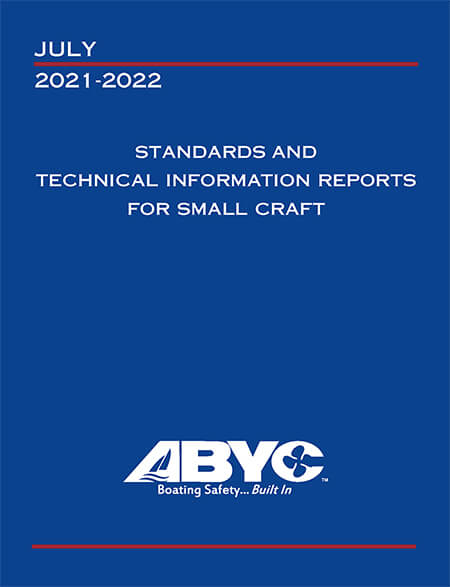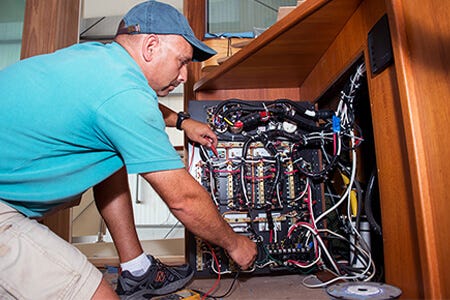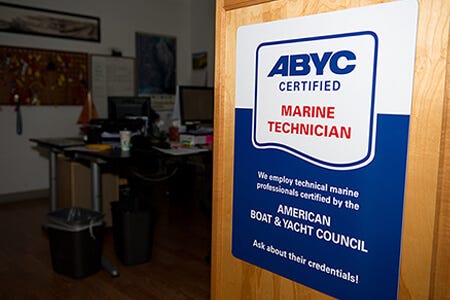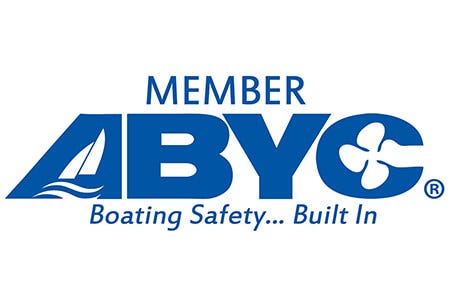

It’s a common misconception that federal laws and regulations govern how boats are designed and built in order to ensure that they’re as safe and dependable as possible. That’s true to a very limited degree; basic safety standards like fire suppression, life jacket, distress signal, and navigation light requirements are in fact covered in the Code of Federal Regulations (CFR), but the vast majority of guidelines that help manufacturers design, build and rig safe, dependable boats are actually created and maintained by an industry group called the American Boat and Yacht Council (ABYC).
Chances are you’ve seen and heard the name a lot of places — maybe an ABYC Certified Technician plaque on the wall of your repair shop, an ABYC Member badge on a manufacturer’s brochure, or a statement about a system on your boat meeting ABYC standards. But who exactly is the ABYC and what do they do?
What Are ABYC Standards?
In the organization’s own words, ABYC “develops voluntary global safety standards for the design, construction, maintenance, and repair of recreational boats.” In other words, ABYC develops and maintains detailed written guidelines for all kinds of systems on vessels ranging from jon boats to superyachts.
ABYC develops and maintains detailed written guidelines for all kinds of systems on vessels ranging from jon boats to superyachts.
These Standards cover just about everything you can think of with the exception of design and construction of the hull itself: electrical systems, fuel systems, ventilation systems, through-hull fittings, ladders and rails, steering systems, even visibility from the helm station.
All of these areas — and many more — are covered in great detail in the Standards. For example, the Standards dictate how wiring runs must be supported (at least every 18 inches), the allowable voltage drop over a wiring run, that soldering can’t be used as the sole means of connecting wires, how much pull a crimped connection should be able to withstand, what color wire to use for certain components, and so on.
In short, if it affects the safety, usability, serviceability or lifespan of your boat, ABYC probably has something to say about it.
If it affects the safety, usability, serviceability or lifespan of your boat, ABYC probably has something to say about it.
The Standards are widely used for reference not only by boat builders but also by marine surveyors, repair technicians and restoration shops. ABYC claims that 90% of recreational boats being manufactured today are built to ABYC Standards.
Who Writes the Standards?
There are more than 80 separate ABYC Standards, each covering a different topic. Examples range from Compass Installation to Lithium Ion Batteries to Diesel Fuel Systems to Seat Structures.
Each Standard is continuously revised and updated by upwards of 400 volunteer experts from across the recreational marine industry.
These include boat, engine, and accessory manufacturers; technicians; insurance professionals; marine surveyors; Coast Guard personnel; trade organization reps and others.
These 400+ volunteers are organized into some 15 Project Technical Committees (PTCs), each of which is assigned a number of related standards. For example, the Hull Piping PTC maintains Standards for bilge pumps, hydraulic systems, potable water systems, through-hulls, etc. New Standards are created as required by advances and changes in boating and boat building.
New Standards and changes to existing Standards go through extensive process review and discussion
New Standards and changes to existing Standards go through extensive process review and discussion by PTC members and other interested parties before they are voted on by the PTC. If the proposed changes pass, they are then reviewed and voted on by a roughly 24-member oversight group called the Technical Board. If the Technical Board also approves the proposed change, it is published. If not, it goes back to the PTC for revision.
In short, any guidance the ABYC publishes is the consensus position of a large and diverse group of industry experts.
Education and Training Programs
In addition to maintaining its Standards, the other main work of ABYC is providing education, training and certification for marine technicians. “Our seminars, workshops and technician certification courses,” the organization says, “are instrumental in increasing the level of knowledge and professionalism throughout the boating industry.” Education and training programs are available for both new and established marine professionals.
the other main work of ABYC is providing education, training and certification for marine technicians.
ABYC’s certification program allows marine professionals to earn the ABYC Certified Technician designation by passing an exam, indicating that they have been trained extensively and that their work will adhere to ABYC standards.
Currently, there are more than 4,500 ABYC Certified Technicians in the U.S. Certifications are valid for five years, and re-certification requires passing another exam as well as completing continuing education requirements.
Currently, there are more than 4,500 ABYC Certified Technicians in the U.S.
Technicians can be certified in one or more of a variety of areas, including Electrical, Gas Engines, Diesel Engines, Composites, Corrosion, A/C and Refrigeration and others. Techs certified in three or more different areas are recognized as Master Technicians.
ABYC also offers an Advisor Certification for marine professionals who don’t physically work on boats, such as surveyors, consultants, brokers and designers.
What Does ABYC Membership Mean?
Marine-oriented businesses of all kinds display stickers or plaques identifying them as ABYC Members. But what does that actually mean? Essentially it means simply that the business supports the work of ABYC through membership dues and in return receives a variety of perks, the most important of which is access to the ABYC Standards. (The Standards are available to non-members but must be purchased for several hundred dollars).
ABYC does important work to make boats better and safer, and any business that chooses to support that work is worthy of a bit of extra consideration.
Note that ABYC Membership isn’t the same as ABYC Certification. Membership simply means that a business has paid membership and met basic requirements. That’s not a bad thing, of course; ABYC does important work to make boats better and safer, and any business that chooses to support that work is worthy of a bit of extra consideration.
ABYC Certification, on the other hand, means that a technician or non-technical marine professional has passed a rigorous exam to prove their expertise.
Do Boat Builders Have to Adhere to ABYC Standards?
All ABYC Standards are completely voluntary. A few of the Standards include some of the same requirements set forth in the Code of Federal Regulations, which are technically required — but by the government, not ABYC. ABYC Standards are consensus best practices, not regulations, and no boat builder is required to follow them.
ABYC Standards are consensus best practices, not regulations, and no boat builder is required to follow them.
In fact, there’s no inspection or certification process to evaluate whether a given boat meets all the standards or not. So any manufacturer can claim they adhere to ABYC Standards; it’s up to the consumer to evaluate whether that’s true or not.
Can Everyday Boaters Access the ABYC Standards?
The complete Standards are available online to all ABYC Members and can be purchased in hard copy by non-members for several hundred dollars ($499.95 + tax and shipping in early 2024). Individual Standards are available for $50.00 each, also in early 2024.
ABYC offers a recreational boater membership level for $200/year, which includes full access to the online Standards as well as other perks.
A common complaint about the ABYC among boat owners has been the fact that the Standards aren’t readily accessible to everyday boaters. Now, though, ABYC offers a recreational boater membership level for $200/year, which includes full access to the online Standards as well as other perks, including the opportunity to participate on Project Technical Committees.
Why Does the ABYC Do What it Does?
Despite the occasional frustration among boat owners and shoppers that the ABYC Standards aren’t freely available to anybody outside the industry, the organization does a huge amount of good for both the recreational marine industry and boaters themselves. So, why devote so much in the way of money and volunteer time and expertise to creating entirely voluntary guidelines? At the end of the day, it’s simple.
The organization's vision statement says it will “maximize customer satisfaction with the boating experience through safety standards for products, service, and repair.” And a happy, safe boating experience is good for everybody involved.




